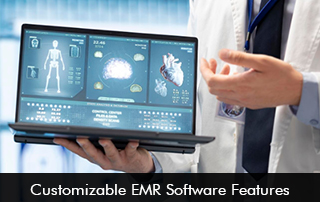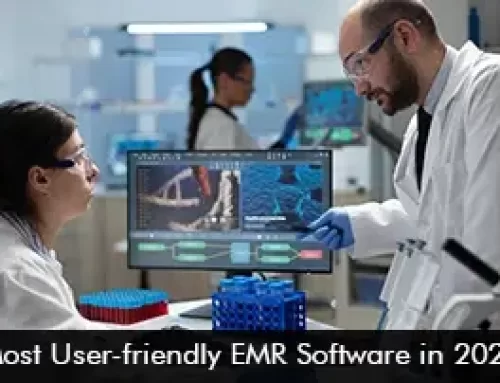EMR software has revolutionized healthcare by digitizing patient records, streamlining workflows, and improving patient care. However, not all healthcare practices operate the same way—each has unique workflows, specialties, and requirements. This is where customizable EMR software becomes invaluable.
Customizable Electronic Medical Record (EMR) allows healthcare providers to tailor features to their specific needs, ensuring efficiency, compliance, and better patient outcomes. Unlike rigid, one-size-fits-all solutions, these adaptable platforms grow with your practice, accommodating changes in regulations, patient volumes, and clinical workflows.
Why Customization Matters in EMR Software
Healthcare providers—whether small clinics, large hospitals, or specialty practices—have different documentation needs, administrative processes, and compliance requirements. A generic EMR system can create inefficiencies, frustrate staff, and even lead to errors in patient care.
Customizable EMR software addresses these challenges by aligning with existing workflows rather than forcing providers to adapt to inflexible systems. This leads to higher user adoption rates, as staff are more likely to embrace a platform that fits naturally into their daily routines. Additionally, tailored documentation tools and decision-support features enhance accuracy, reducing the risk of medical errors.
Perhaps most importantly, customizable EMRs ensure compliance with ever-changing healthcare regulations. From HIPAA to MIPS reporting, practices can configure their systems to meet specific legal requirements without cumbersome workarounds.
Now, let’s explore the key customizable features that make modern EMR software so powerful.
Customizable Patient Charting and EMR Software Documentation
One of the most critical aspects of EMR software is patient charting. Every medical specialty has unique documentation requirements—what works for a cardiologist won’t necessarily suit a pediatrician or a physical therapist.
Customizable EMRs allow providers to create or modify templates to match their specific needs. For example, a dermatology practice might design templates for skin lesion documentation, while an orthopedic clinic could customize forms for surgical notes. Smart forms that auto-populate based on patient history further reduce manual data entry, saving time and minimizing errors.
SOAP (Subjective, Objective, Assessment, Plan) notes, a cornerstone of medical documentation, can also be tailored. Providers can adjust sections, incorporate dropdown menus for common diagnoses, and even integrate voice-to-text functionality for faster note-taking. This flexibility ensures thorough, standardized documentation while accommodating individual preferences.
Adaptable Workflows and EMR Software Dashboards
No two healthcare practices operate exactly alike, which is why rigid workflows can hinder productivity. Customizable EMR software allows practices to design workflows that mirror their real-world processes.
Role-based dashboards are a prime example. Physicians, nurses, and administrative staff each need different information at their fingertips. Doctors may prioritize patient charts and lab results, while nurses focus on medication administration and vital signs. Customizable dashboards let users rearrange widgets, set priority alerts, and access the most relevant data with minimal clicks.
Automation is another game-changer. Practices can set up reminders for follow-up visits, define approval chains for lab orders, and customize patient communication, such as automated post-visit surveys or vaccination reminders. These tailored workflows reduce administrative burdens and ensure consistent patient care.
Tailored Reporting and Analytics
Data-driven decision-making is essential in modern healthcare, but generic reports often fail to provide actionable insights. Customizable EMRs empower practices to generate reports that align with their specific goals.
Clinicians might need reports on chronic disease management outcomes, while administrators may focus on billing efficiency or patient wait times. With drag-and-drop report builders, practices can select the exact data fields they need, schedule automated report generation, and even create real-time analytics dashboards.
These insights help identify trends, optimize operations, and demonstrate compliance with regulatory requirements. For instance, a practice participating in value-based care programs can easily track quality metrics and adjust protocols accordingly.
Personalized e-Prescribing and Medication Management
Prescribing medications is a daily task for most providers, and customizable EMRs streamline this process. Physicians can save favorite medications, set default dosage instructions, and configure allergy alerts based on their prescribing habits.
Integration with pharmacy networks adds another layer of convenience. Providers can select preferred pharmacies for each patient, automate refill requests, and even track medication adherence. These features reduce prescription errors, improve patient compliance, and save valuable time during busy clinic days.
Custom EMR Software Patient Portal Features
Patient engagement is a cornerstone of effective healthcare, and customizable patient portals play a key role. Practices can tailor communication tools to their needs, whether it’s automated appointment reminders via SMS, email, or phone calls. Secure messaging templates enable staff to quickly respond to common patient inquiries, while customized educational materials, such as post-operative instructions or guides for chronic disease management, enhance patient understanding.
Pre-visit health questionnaires are another customizable feature. Practices can design forms tailored to specific specialties, such as mental health screenings or preoperative assessments. This not only streamlines the intake process but also ensures providers have up-to-date information before the patient arrives.
Flexible Billing and Revenue Cycle Management
Billing is a complex and often frustrating aspect of healthcare administration, but customizable EMRs can simplify the process. Specialty-specific billing templates ensure accurate coding, whether it’s DSM-5 codes for mental health practices or detailed procedure codes for surgical centers. Automated claim scrubbing reduces denials by catching errors before submission.
Financial flexibility is another advantage. Practices can set up customized payment plans for self-pay patients, automate payment reminders, and integrate insurance eligibility checks into the workflow. These features improve cash flow and reduce the administrative burden on staff.
The Future of EMR Software is Customization
The healthcare landscape is constantly evolving, and practices need EMR software that can adapt alongside them. Customizable EMRs are no longer a luxury—they’re a necessity for clinics and hospitals that want to improve efficiency, enhance patient care, and stay compliant with regulations.
By offering tailored documentation, adaptable workflows, and personalized patient engagement tools, these systems empower providers to focus on what matters most: delivering high-quality care. If your current EMR feels restrictive, it may be time to explore a solution designed to grow with your practice.
The right customizable EMR doesn’t just store patient data—it transforms the way you work.







